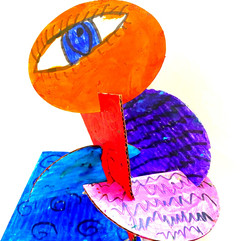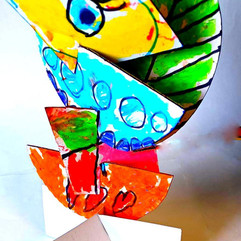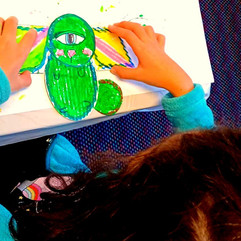Miro & Calder
Updated: Oct 15, 2022
Miro & Calder

Miro
Last week we began our 40,000-year journey in Spain, with Cave painting symbols and went around the world looking at other Ancient Cultures, arriving full circle back in Spain to connect the dots with the colorful and playful art of Spanish artist Joan Miro. He was born in Barcelona in 1893, and his work was greatly influenced by living by the sea and the distinctive Catalan style. While living in Paris, in 1928 he exhibited with Salvador Dali, Rene Magritte and other Surrealist artists. He combined Surrealism with his own signature style to become one of the most influential artists of the 20th century. Miro had an enormous influence on many other great artists including Picasso, Dali, and Calder. He was considered very Modern, but his work contained universal symbols that can be traced back to Cave Paintings and Petroglyphs. He created an astounding body of work, including 2,000 oil paintings, 500 sculptures, numerous public mural projects and he was one of the most prolific creators of original lithographs and etchings. Miro is one of the most widely collected and exhibited artists, and in 1976 The Joan Miro Foundation of Contemporary Arts opened in Barcelona. He was also named Doctor Honoris by the University of Barcelona for his contribution to the Arts and Culture.

Calder
Alexander Calder came from a family of professional artists. His grandfather, sculptor Alexander Milne Calder, was born in Scotland, immigrated to Philadelphia in 1868, and is best known for the statue of William Penn on top of Philadelphia City Hall's tower. His father, Alexander Stirling Calder, was also a well-known sculptor and his mother, Nanette Lederer Calder, was a professional portrait artist, who studied at the Sorbonne in Paris and the Pennsylvania Academy of the Fine Arts. Calder's parents discouraged him from the life of an artist, so he reluctantly studied mechanical engineering but ultimately pursued art.
In 1926, after showing paintings at The Artists' Gallery in New York he moved to Paris and it was there that he met Joan Miró, who became an important influence and close friend. He enrolled in the Académie de la Grande Chaumière, and had a studio in the heart of the artist colony in Montparnasse Quarter. While in Paris, Calder met and became friends with a number of avant-garde artists, including Fernand Léger, Jean Arp, and Marcel Duchamp, and Mondrian, who also inspired him toward abstract art. The forms and primary colors of Miro and Mondrian figured prominently in his sculpture and prints throughout his career.
By 1931, Calder adapted his painting style into sculptures. He pioneered the art form he is best known for, by combining his mechanical engineering background and artistic style to air born sculptures powered by motors and called “Mobiles”. In 1952 he represented the United States at the Venice Biennale and was awarded the main prize for sculpture. He was best known for his Mobiles and large-scale sculptures, but he was also a prolific printmaker, often creating posters and prints for advocacy and to protest the Vietnam War. He was awarded the Presidential Medal of Freedom by President Gerald Ford.
We often talk about inspiration and where it comes from, nature, other artists, or cultures. This past week we looked at the art of Miro and Calder and their relation to each other and the previous lesson of ancient cultures and symbols. Both artists used primary colors and geometric shapes, lines and some of the universal symbols that are found in Petroglyphs, Cave art, Aboriginal art and Hieroglyphics. The class was inspired by their work to create their own interpretations of mixed media drawings and sculptures, using the same colors, symbols and geometric shapes.
ABERNETHY CLASS
TABOR CLASS

















































































Comments